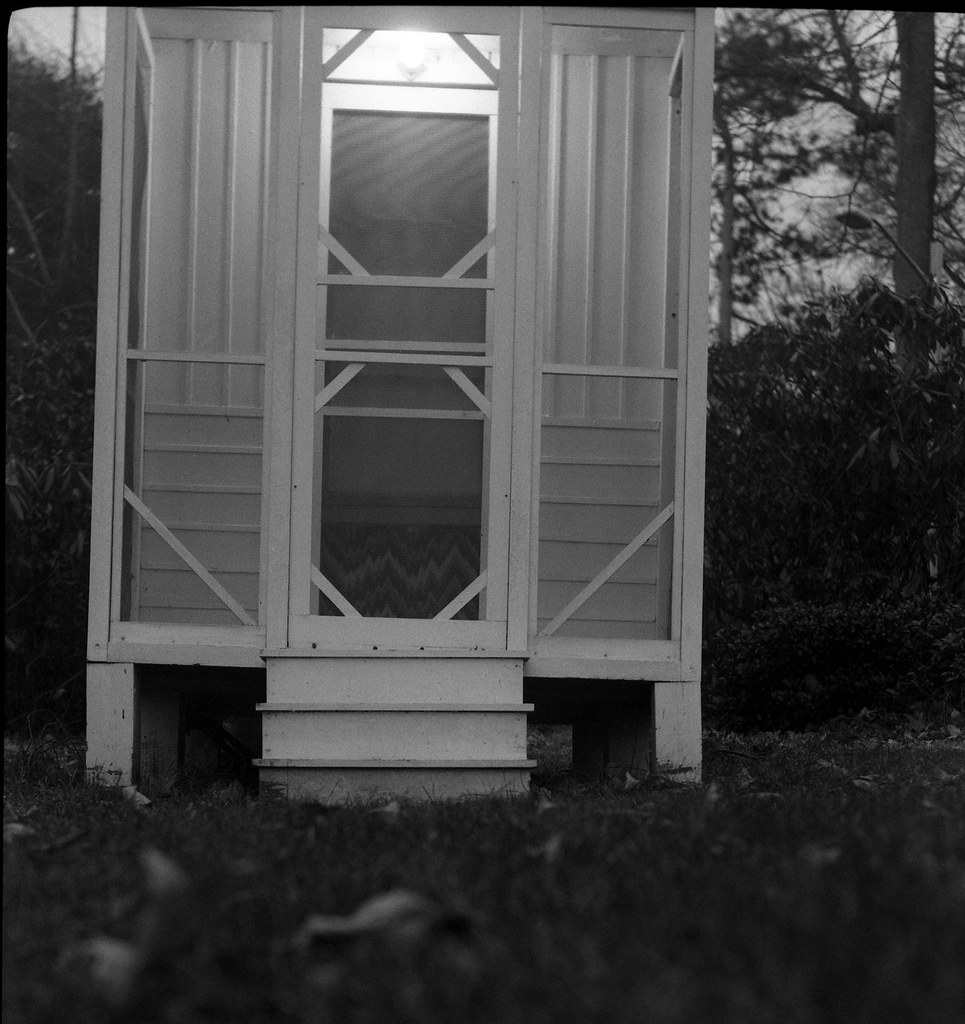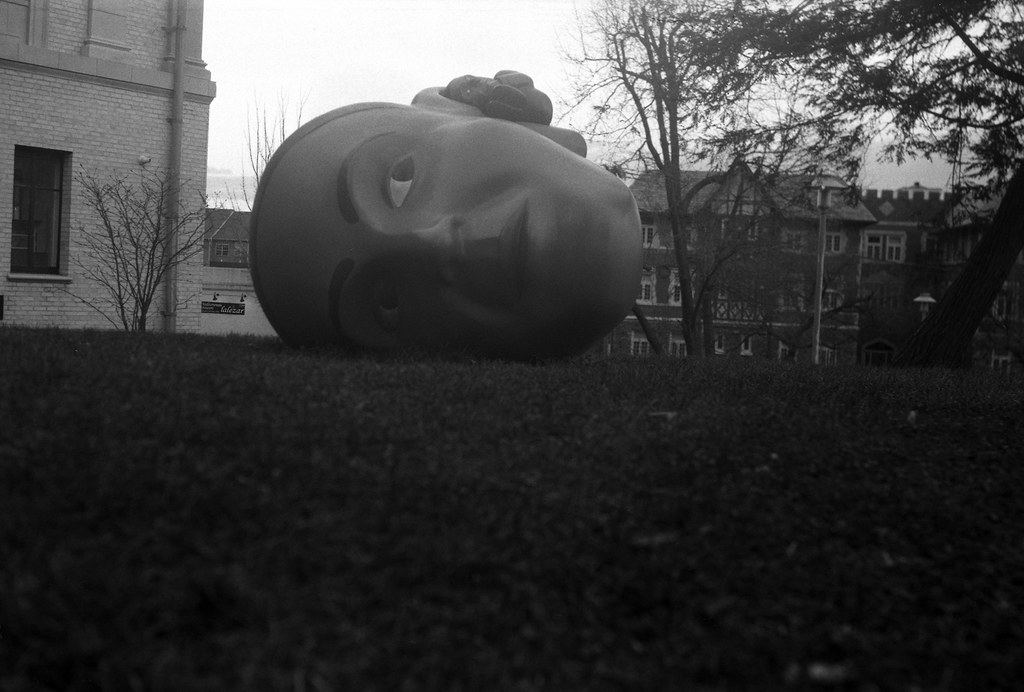| View previous topic :: View next topic |
| Author |
Message |
Nesster


Joined: 24 Apr 2008
Posts: 5883
Location: NJ, USA
Expire: 2014-02-20
|
 Posted: Sun Dec 09, 2012 1:58 pm Post subject: 1919: 1 Autographic Kodak Special Model A Posted: Sun Dec 09, 2012 1:58 pm Post subject: 1919: 1 Autographic Kodak Special Model A |
 |
|
Nesster wrote:
The camera:

wollensak panorama by Nesster, on Flickr
This model was made between 1919 and 1920. After 93 years, the Optimo shutter still works perfectly, the Kodak Special Anastigmat 110mm 6.3 is still a good performer... but the bellows are shot. Over a few months I patched them up and took these pictures in low light before I folded the camera up. Once folded the bellows disintegrated entirely. I have a stash of NOS Kodak bellows however, and this camera has potential, so when I get time, I'll see about putting a new one in the camera.
All shots with Holga/Foma 400, HC-110, Epson 4490. Exposures were between 1/4 and 1/2

On the Montclair Art Museum grounds by Nesster, on Flickr

Head, on lawn by Nesster, on Flickr
#3

_________________
-Jussi
Camera photos
Print Photographica
|
|
| Back to top |
|
 |
Attila


Joined: 24 Feb 2007
Posts: 57865
Location: Hungary
Expire: 2025-11-18
|
 Posted: Sun Dec 09, 2012 2:35 pm Post subject: Posted: Sun Dec 09, 2012 2:35 pm Post subject: |
 |
|
Attila wrote:
Hey this is something, excellent result!
_________________
-------------------------------
Items on sale on Ebay
Sony NEX-7 Carl Zeiss Planar 85mm f1.4, Minolta MD 35mm f1.8, Konica 135mm f2.5, Minolta MD 50mm f1.2, Minolta MD 250mm f5.6, Carl Zeiss Sonnar 180mm f2.8
|
|
| Back to top |
|
 |
iangreenhalgh1


Joined: 18 Mar 2011
Posts: 15679
Expire: 2014-01-07
|
 Posted: Sun Dec 09, 2012 3:18 pm Post subject: Posted: Sun Dec 09, 2012 3:18 pm Post subject: |
 |
|
iangreenhalgh1 wrote:
Not bad at all. I have a Kodak 3A in very nice condition, need to modify it to use 120, I forget which lens it has now, it's a dialyte type 4 element but I don't remember the specifics.
_________________
I don't care who designed it, who made it or what country it comes from - I just enjoy using it! |
|
| Back to top |
|
 |
luisalegria


Joined: 07 Mar 2008
Posts: 6602
Location: San Francisco, USA
Expire: 2018-01-18
|
 Posted: Sun Dec 09, 2012 6:20 pm Post subject: Posted: Sun Dec 09, 2012 6:20 pm Post subject: |
 |
|
luisalegria wrote:
Bellows are a typical failure point for old Kodaks. I think Kodak cut some corners somewhere.
Anyway, your shutter is an excellent piece and I think underappreciated.
I have three Optimos and all (save a minor repair in one case) are working well after nearly a hundred years.
I can't say the same for Deckel Compounds, which were the comparable competition.
I have several of these too, and all needed thorough disssembly, clean and lube to make them work.
_________________
I like Pentax DSLR's, Exaktas, M42 bodies of all kinds, strange and cheap Japanese lenses, and am dabbling in medium format/Speed Graphic work. |
|
| Back to top |
|
 |
Mos6502


Joined: 20 Jun 2011
Posts: 960
Location: Austin
|
 Posted: Sun Dec 09, 2012 7:25 pm Post subject: Posted: Sun Dec 09, 2012 7:25 pm Post subject: |
 |
|
Mos6502 wrote:
Bellows in general are a failure point. Although I've had better luck with Kodak bellows than with any other brand. I think Ansco bellows are probably the worst, I don't know what material they used but it pretty much just turns to dust if you look at it wrong these days. I've got a Kodak Jr. with the rapid rectilinear lens, and the bellows are still in excellent condition - unfortunately the rest of the camera has taken a beating. |
|
| Back to top |
|
 |
skida


Joined: 02 Mar 2012
Posts: 1826
Location: North East England
|
 Posted: Sun Dec 09, 2012 7:26 pm Post subject: Posted: Sun Dec 09, 2012 7:26 pm Post subject: |
 |
|
skida wrote:
| luisalegria wrote: |
| Bellows are a typical failure point for old Kodaks. I think Kodak cut some corners somewhere. |
Yeah! Only 93 years before failing! Complain to Kodak (before they disappear). 
Interesting shots with a nice "feel". |
|
| Back to top |
|
 |
luisalegria


Joined: 07 Mar 2008
Posts: 6602
Location: San Francisco, USA
Expire: 2018-01-18
|
 Posted: Sun Dec 09, 2012 7:48 pm Post subject: Posted: Sun Dec 09, 2012 7:48 pm Post subject: |
 |
|
luisalegria wrote:
This can sound silly, I know, but the fact is that old German camera bellows from good makes tend to be in better condition that those of Kodaks of similar age.
_________________
I like Pentax DSLR's, Exaktas, M42 bodies of all kinds, strange and cheap Japanese lenses, and am dabbling in medium format/Speed Graphic work. |
|
| Back to top |
|
 |
Nesster


Joined: 24 Apr 2008
Posts: 5883
Location: NJ, USA
Expire: 2014-02-20
|
 Posted: Mon Dec 10, 2012 12:01 am Post subject: Posted: Mon Dec 10, 2012 12:01 am Post subject: |
 |
|
Nesster wrote:
| luisalegria wrote: |
| This can sound silly, I know, but the fact is that old German camera bellows from good makes tend to be in better condition that those of Kodaks of similar age. |
This is true. The Kodak bellows that are good tend to be from earlier in the century, or then 620 cameras from the 40's and later
_________________
-Jussi
Camera photos
Print Photographica
|
|
| Back to top |
|
 |
Bogie


Joined: 22 Jan 2011
Posts: 173
Location: Houten, The Netherlands
|
 Posted: Thu Dec 27, 2012 11:55 am Post subject: Posted: Thu Dec 27, 2012 11:55 am Post subject: |
 |
|
Bogie wrote:
Wow, you have got quite a lot of shutterspeeds on that old folder (even to 1/300s.)   The lenses of those old Kodak-camera's ain't bad, don't you think? I was also pleasantly surprised by the results of the Eastman Kodak No.2 Folding Hawk-Eye Model B (1926) which I own. The lenses of those old Kodak-camera's ain't bad, don't you think? I was also pleasantly surprised by the results of the Eastman Kodak No.2 Folding Hawk-Eye Model B (1926) which I own.
_________________
35mm, 120mm & digital camera-user |
|
| Back to top |
|
 |
luisalegria


Joined: 07 Mar 2008
Posts: 6602
Location: San Francisco, USA
Expire: 2018-01-18
|
 Posted: Thu Dec 27, 2012 10:26 pm Post subject: Posted: Thu Dec 27, 2012 10:26 pm Post subject: |
 |
|
luisalegria wrote:
The Optimo was a very high-tech shutter for that time, because it claimed such a high speed. This was not common then. The equivalent Compur and Compound shutters of the same vintage yielded 1/250 for this size shutter.
There is no easy way to tell if it could actually reach this speed. Most leaf shutters don't hit their top speeds. The apparent precision of these settings is an illusion.
Many other air-regulated shutter designs, even from the turn of the 19th century had a similarly wide range of speeds, but the usual top speed was 1/150.
_________________
I like Pentax DSLR's, Exaktas, M42 bodies of all kinds, strange and cheap Japanese lenses, and am dabbling in medium format/Speed Graphic work. |
|
| Back to top |
|
 |
|
|
|
You cannot post new topics in this forum
You cannot reply to topics in this forum
You cannot edit your posts in this forum
You cannot delete your posts in this forum
You cannot vote in polls in this forum
|
